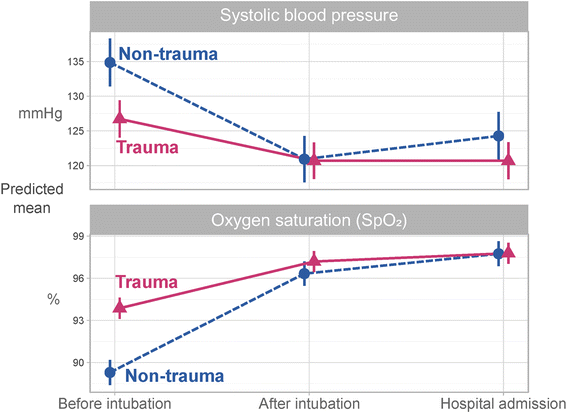Hypoxia and hypotension in patients intubated by physician staffed helicopter emergency medical services - a prospective observational multi-centre study
- PMID: 28693491
- PMCID: PMC5504565
- DOI: 10.1186/s12873-017-0134-5
Hypoxia and hypotension in patients intubated by physician staffed helicopter emergency medical services - a prospective observational multi-centre study
Abstract
Background: The effective treatment of airway compromise in trauma and non-trauma patients is important. Hypoxia and hypotension are predictors of negative patient outcomes and increased mortality, and may be important quality indicators of care provided by emergency medical services. Excluding cardiac arrests, critical trauma and non-trauma patients remain the two major groups to which helicopter emergency medical services (HEMS) are dispatched. Several studies describe the impact of pre-hospital hypoxia or hypotension on trauma patients, but few studies compare this in trauma and non-trauma patients. The primary aim was to describe the incidence of pre-hospital hypoxia and hypotension in the two groups receiving pre-hospital tracheal intubation (TI) by physician-staffed HEMS.
Methods: Data were collected prospectively over a 12-month period, using a uniform Utstein-style airway template. Twenty-one physician-staffed HEMS in Europe and Australia participated. We compared peripheral oxygen saturation and systolic blood pressure before and after definitive airway management. Data were analysed using Cochran-Mantel-Haenszel methods and mixed-effects models.
Results: Eight hundred forty three trauma patients and 422 non-trauma patients receiving pre-hospital TI were included. Non-trauma patients had significantly lower predicted mean pre-intervention SpO2 compared to trauma patients. Post-intervention and admission SpO2 for the two groups were comparable. However, 3% in both groups were still hypoxic at admission. For hypotension, the differences between the groups were less prominent. However, 9% of trauma and 10% of non-trauma patients were still hypotensive at admission. There was no difference in short-term survival between trauma (97%) and non-trauma patients (95%). Decreased level of consciousness was the most frequent indication for TI, and was associated with increased survival to hospital (cOR 2.8; 95% CI: 1.4-5.4).
Conclusions: Our results showed that non-trauma patients had a higher incidence of hypoxia before TI than trauma patients, but few were hypoxic at admission. The difference for hypotension was less prominent, but one in ten patients were still hypotensive at admission. Further investigations are needed to identify reversible causes that may be corrected to improve haemodynamics in the pre-hospital setting. We found high survival rates to hospital in both groups, suggesting that physician-staffed HEMS provide high-quality emergency airway management in trauma and non-trauma patients.
Trial registration: Clinicaltrials.gov Identifier: NCT01502111 . Registered 22 Desember 2011.
Keywords: Advanced trauma life support; Air ambulance; Airway management; Critical care; Helicopter emergency medical services; Intubation; Physician staffed HEMS.
Conflict of interest statement
Ethics approval and consent to participate
Norway: The Regional Committee for Medical and Health Research Ethics in Western Norway considered the study as a service evaluation study and exempted it from ethical review (Reference number: 2011/1123/REK VEST). Australia: The Royal Prince Alfred Hospital Human Research Ethics Committee approved the study. Hungary: Egészségügyi Tudományos Tanács, Tudományos és Kutatásetikai Bizottság – Scientific and Research Ethics Committee of the Medical Research Council approved the study (Reference number: 98/2012/EKU (3/PI/12.)). Switzerland: Ethikkommission beider Basel approved the study (Reference number: EK: 233/12). England: The Barts Health R&D department (for London’s Air Ambulance), and the UK National Institute for Health Research and local Ethics and Research Committee (for Kent Surrey Sussex HEMS), approved the study as a service evaluation project and exempted it from ethical review. Finland: The Ethics Committee of Kuopio University Hospital, Kuopio, approved the study (Reference number Kupio / Vantaa / Tampere132/2011, and Tampere ETL code R12020). Requirement for written informed consents was waived.
Consent for publication
See above. Consent for publication is not applicable.
Competing interests
The authors declare they have no conflict of interest.
Publisher’s Note
Springer Nature remains neutral with regard to jurisdictional claims in published maps and institutional affiliations.
Figures


References
-
- Hossfeld B, Bein B, Boettiger BW, Bohn A, Fischer M, Graesner JT, Hinkelbein J, Kill C, Lott C, Popp E, et al. Recommended practice for out-of-hospital emergency anaesthesia in adults: statement from the out-of-hospital emergency Anaesthesia working Group of the Emergency Medicine Research Group of the German Society of Anaesthesiology and Intensive Care. Eur J Anaesthesiol. 2016;33(12):881–897. doi: 10.1097/EJA.0000000000000533. - DOI - PubMed
-
- Major trauma. Assessment and initial management [NG39]. London, National Institute for Health and Care Excellence; 2016. - PubMed
Publication types
MeSH terms
Substances
Associated data
LinkOut - more resources
Full Text Sources
Other Literature Sources
Medical

